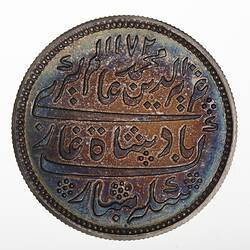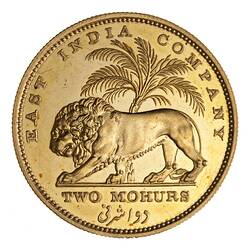Summary
1 Rupee, Issued by, East India Company, Madras Presidency, India, 1172 AH Regnal year 6
Third European Style (1823-1825)
Minted by Calcutta Mint
Note: Known as the Madras Rupee because of their design, these coins were struck for circulation in the Chittagong and Dacca regions of the Bengal Presidency
Obverse Description
Legend in Persian script (translation: 1172 the auspicious coin of the Victorious Emperor Chosen of the faith of Muhammad, Alamgir) Note: the legend and date are of a frozen type, they do not name the issuer nor give the date of production
Reverse Description
Legend in Persian script (translation: Struck at the Arcot Mint in the 7th year of his tranquil prosperity) with the rose mark Note: the legend and mint name are of a frozen type, they do not name the mint nor give the year of production.
Edge Description
Milled
Significance
The East India Company obtained permission to strike Arkat style rupees from the Subah of Arkat (Arcot) in 1742. The first actual production under this was in 1759 in the name of Alamgir II and bear the Hegira date 1172 with the regnal year 6. The legends and date were retained unchanged until production ceased in 1835 and are referred to as frozen. This machine struck 1 rupee although produced in the period 1823 to 1825 AD thus retains the original date. The coin also refers to the Arkat mint although struck at the Calcutta mint, indicated bt the rose on the reverse, for circulation in the Dacca and Chittagong districts of the Bengal Presidency.
More Information
-
Collecting Areas
-
Acquisition Information
Transfer from National Gallery of Victoria (NGV), 15 Mar 1976
-
Date Issued
1823-1825 AD
-
Issued By
-
Mint
-
Denomination
-
Series
-
Material
Silver
-
Axis
12
-
Classification
-
Category
-
Discipline
-
Type of item
-
Dimensions
26 mm (Outside Diameter), 11.63 g (Weight)
-
Shape
Round
-
References
Pridmore 263 KM#427
[Book] Pridmore, Fred. 1975. The Coins of the British Commonwealth of Nations, Part 4, India. 1., 40 & 82 Pages
[Book] Bruce, Colin R. 2006. Standard Catalogue of World Coins 1801 - 1900.
-
Keywords
British Commonwealth Coins, British Commonwealth and Empire Coins





